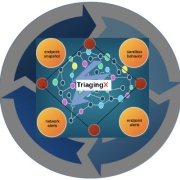Endpoint Detection and Response (EDR) is a cybersecurity solution that focuses on detecting, investigating, and mitigating advanced cyber threats at the endpoint level. Organizations use EDR solutions to enhance their threat detection capabilities and respond effectively to security incidents.
EDR solutions combine real-time continuous monitoring and collection of endpoint data with rule-based automated response and analysis capabilities. This enables organizations to rapidly identify and respond to threats, such as malware, ransomware, and sophisticated attacks. The solutions provide deep visibility into endpoint activities, allowing security teams to understand the nature and scope of an attack, and take appropriate actions to mitigate risks.
What are the critical features of EDR solutions?
What benefits and ROI should users look for in EDR solutions?
In healthcare, EDR solutions secure sensitive patient data, ensuring compliance with regulations like HIPAA. Financial institutions leverage EDR for real-time monitoring of transactions and endpoints to prevent fraud. In manufacturing, EDR helps protect against industrial espionage and intellectual property theft by safeguarding endpoints connected to production systems.
EDR solutions are essential for organizations aiming to improve their cybersecurity posture, providing advanced threat detection, real-time response, and comprehensive endpoint visibility.



























































































An EDR system monitors endpoint and network events by recording the information in a central database. That information then undergoes further analysis and detection, followed by investigation and reporting, whereby alerts are triggered. Through the use of analytic tools, companies can improve security by identifying tasks that can deflect attacks and threats. If a threat can be contained at the endpoint, an EDR system can eliminate it and possibly prevent it from spreading further. The combination of actionable intelligence along with behavioral analysis is applied to endpoint data, which helps stop a breach incident from occurring. Although no two EDR systems may offer the same capabilities or features, all endpoint detection and response systems aim to achieve the same end goal: to monitor and detect anomalies in an effort to prevent threats.
The number of endpoints attached to networks is on the rise, making EDR (endpoint detection and response) more significant than ever before. Because endpoints are easy targets for cyberattackers to infiltrate a network, endpoint visibility is critical for organizations. Interestingly, because EDR solutions operate based on machine learning algorithms, they are more likely to spot unknown types of malware. This can be beneficial to your company because it will allow you to make behavior-based decisions. In addition, malicious behavior patterns will not be able to bypass EDR solutions, adding an extra layer of security to your system.
The evolution of workplace mobility is forcing more employees to connect to their internet and off-site endpoints from home. Without proper security measures in place, devices can become increasingly vulnerable, making it easier for malicious attackers to take advantage. An EDR system provides enhanced security and surpasses firewalls and other antivirus solutions.
It is advised to deploy a combination of EDR (endpoint detection and response) and EPP (endpoint protection platforms) to protect endpoints because while EPP works to prevent threats before they even reach the endpoint, EDR works on the assumption of breach, primarily focusing on attacks that have already successfully entered the environment. EDR strives to rapidly respond to threats, assuming that complete protection is never 100% possible. EPP acts as a first line of defense and in many cases makes it more difficult for attackers to break through the perimeter. EDR however, views endpoints as a weak link of the security perimeter and provides the visibility needed to react to an attack.
Because it is difficult and sometimes impossible for an EPP to entirely block each and every threat, it is ideal for an organization to implement both an EDR and an EPP security solution. With both systems in place, it is less likely for sophisticated threats to evade the perimeter and wreak havoc on your network and across your environment.
Another major difference between the two systems is that EPP requires minimal supervision after its initial installation. However, EDR systems rely on active investigation and analysis to successfully respond to attacks. The two types of endpoint protection solutions do not replace each other, but rather complement one another. Ideally, organizations and enterprises that can combine both will be prepared to combat cybersecurity challenges and will have the protection they need to ensure complete security.
The benefits of an EDR (endpoint detection and response) system include:
Here are some of the features you should consider when looking for an EDR system:
Endpoint Detection and Response (EDR) software is a critical component of modern cybersecurity strategies. It helps organizations detect, investigate, and respond to advanced threats and attacks on their endpoints. There are several types of EDR available in the market, each offering unique features and capabilities. Here are some of the different types of EDR software:
1. Standalone EDR: This type of EDR software focuses solely on endpoint detection and response capabilities. It provides real-time monitoring, threat detection, and incident response features. Standalone EDR solutions are often preferred by organizations that already have other security tools in place and need a dedicated EDR solution to enhance their endpoint security.
2. Integrated EDR: Integrated EDR software is part of a broader security suite or platform that combines multiple security functionalities. These platforms often include features like antivirus, firewalls, intrusion detection, prevention systems, and more. Integrated EDR solutions offer a comprehensive approach to endpoint security, allowing organizations to manage multiple security aspects from a single console.
3. Cloud-based EDR: Cloud-based EDR solutions leverage the power of the cloud to provide scalable and flexible endpoint security. These solutions offer real-time threat detection and response capabilities, with the advantage of centralized management and automatic updates. Cloud-based EDR software is particularly beneficial for organizations with distributed or remote workforces, as it can protect endpoints regardless of their location.
4. Managed EDR: Managed EDR solutions are outsourced to a third-party provider who takes care of the monitoring, detection, and response activities. This type of EDR software is ideal for organizations with limited internal resources or expertise in cybersecurity. Managed EDR providers offer 24/7 monitoring, incident response, and threat-hunting services, ensuring that organizations have continuous protection against advanced threats.
5. Open-source EDR: Open-source EDR software is freely available and can be customized and modified by organizations according to their specific needs. This type of EDR software allows organizations to have complete control over their endpoint security and can be particularly useful for those with unique requirements or limited budgets.
Endpoint Detection and Response (EDR) technologies have been evolving rapidly, particularly with the integration of artificial intelligence (AI) to enhance their capabilities.
Predictive Analytics: Modern EDR systems are incorporating AI-driven predictive analytics to anticipate threats before they occur. By analyzing patterns and anomalies in endpoint data, AI models can predict malicious activities and flag them preemptively, allowing security teams to act before a breach happens.
Automated Response: AI is increasingly used to automate responses to detected threats. This capability allows EDR systems to instantly contain and remediate threats without human intervention, significantly reducing response times and the potential impact of security incidents.
Behavioral Analysis: AI algorithms are being refined to perform more sophisticated behavioral analysis. Unlike traditional signature-based methods, behavioral analysis can identify malware based on how it behaves, making it possible to detect zero-day threats and advanced persistent threats (APTs) that have not been previously identified.
Enhanced Threat Hunting: AI enhances threat hunting capabilities in EDR systems by sifting through vast amounts of data to identify anomalies and potential threats. This allows security analysts to focus on investigating the most serious risks, improving the efficiency and effectiveness of threat hunting operations.
Self-Learning Systems: EDR solutions are evolving into self-learning systems that adapt to the changing behavior of users and the IT environment. AI models continually learn from new data, improving their accuracy in detecting threats over time without needing constant updates or maintenance.
These AI-driven advancements are making EDR systems more proactive, intelligent, and efficient, enabling them to better cope with the volume and sophistication of modern cyber threats. As AI technology continues to mature, it will further enhance the capabilities of EDR platforms, leading to more autonomous and highly adaptive cybersecurity defenses.
EDR solutions streamline incident response times by providing real-time monitoring and analysis of endpoint activities. These tools enable you to quickly detect and contain threats, reducing dwell time and preventing widespread damage. Automated alerts and detailed forensic data help your security teams respond swiftly and accurately to incidents.
What are the key features of an effective EDR solution?An effective EDR solution offers comprehensive threat detection, incident response, threat hunting, and forensic analysis. Look for features such as automated alerts, real-time monitoring, behavior analysis, machine learning, and advanced analytics. An intuitive user interface and integration with other security tools enhance overall efficiency and effectiveness.
How does EDR differ from traditional antivirus software?Traditional antivirus software primarily focuses on signature-based detection of known malware. In contrast, EDR solutions offer more advanced capabilities like behavioral analysis, threat intelligence integration, and real-time monitoring. EDR can detect and respond to both known and unknown threats, providing a multi-layered approach to endpoint security.
Can EDR solutions help with compliance requirements?Yes, EDR solutions can assist with compliance requirements by providing detailed logs, reports, and forensic data necessary for audits and regulatory standards. They help ensure that you can demonstrate adherence to cybersecurity best practices and regulations such as GDPR, HIPAA, and PCI-DSS by maintaining comprehensive records of endpoint activities.
What are the challenges in implementing EDR solutions?Implementing EDR solutions can present challenges such as high costs, complexity of integration with existing systems, and the need for specialized skills to manage and interpret data. Overcoming these challenges requires careful planning, selecting the right vendor, and possibly investing in training for your security team to fully leverage the capabilities of EDR tools.